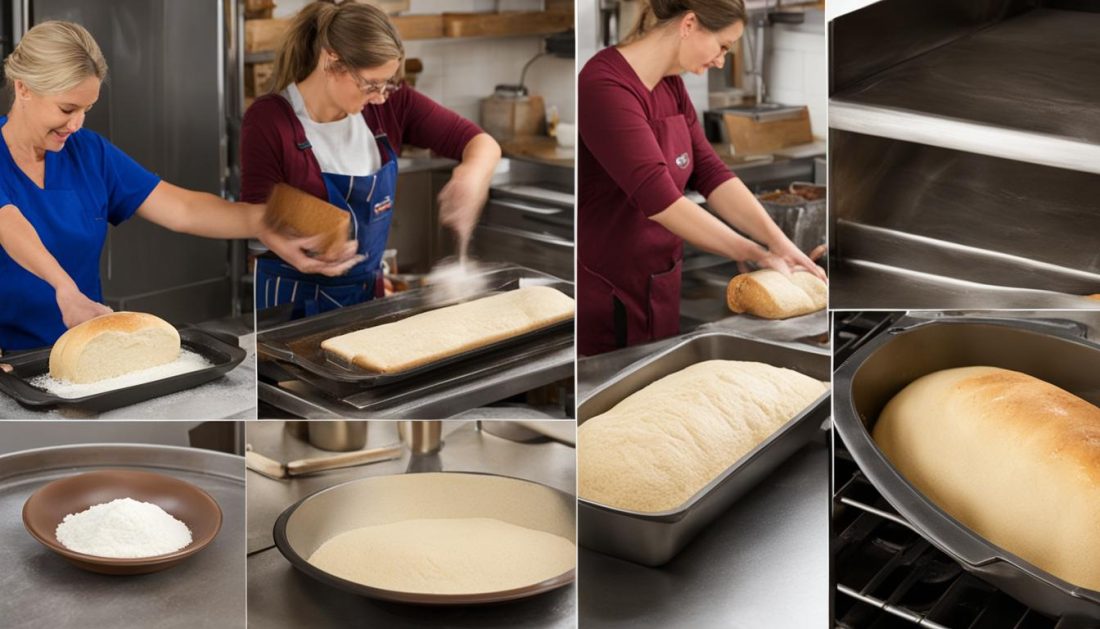Welcome to our comprehensive guide to bread making for beginners. If you’ve always wanted to try making homemade bread but didn’t know where to start, you’ve come to the right place. We’ll walk you through the process step-by-step, from understanding the basic ingredients to troubleshooting common issues.
With our easy bread recipes, you’ll be able to create delicious, fresh bread in no time. Whether you’re a seasoned baker or a complete novice, our guide is designed to help you learn the essential techniques and gain the confidence you need to produce perfect loaves every time.
Baking the Bread
Once your oven is heated, it’s time to put your bread in. Place your bread on the middle rack in the oven and set the timer according to your recipe. Avoid opening the oven door during the first 15-20 minutes of baking, as this can cause your bread to deflate.
Determining Doneness
To ensure that your bread is fully cooked, use a digital thermometer to measure the internal temperature. For most bread, the center should reach 190-200°F (88-93°C). You can also tap the bottom of the bread to check for a hollow sound, which indicates that it is fully cooked.
Cooling the Bread
After you’ve determined that your bread is fully cooked, remove it from the oven and allow it to cool. Place it on a wire rack to cool for at least 30 minutes before slicing. This will prevent it from becoming soggy on the bottom.
Congratulations! You’ve successfully baked your own bread using our step-by-step bread making guide. Enjoy your fresh, homemade bread with butter, jam, or your favorite topping.
In the next section, we’ll discuss common bread-making issues and how to troubleshoot them.
Troubleshooting Common Issues
Don’t get discouraged if your first few loaves of bread don’t turn out perfectly. Bread making is both an art and a science, and even the most experienced bakers run into problems. But with a little troubleshooting, you can improve your bread making skills and avoid common issues.
Issue: Dense Loaves
If your bread turns out dense and heavy, it’s likely due to under-kneading or under-proofing the dough. Make sure to knead the dough until it’s smooth and elastic, and give it enough time to rise. Also, be careful not to over-flour the dough or your bread will be too dry and dense.
Issue: Uneven Rise
If your bread rises unevenly, it could be due to uneven shaping or insufficient proofing. Make sure to shape your dough evenly and allow enough time for it to rise. Be sure to place the loaf in a warm, draft-free location to encourage even rising.
Issue: Burnt Crust
If your bread has a burnt crust, it’s likely due to baking at too high of a temperature or for too long. Make sure to preheat your oven properly and set the timer according to the recipe instructions. If your oven runs hot, consider lowering the temperature or reducing the baking time.
With these tips, you’ll be well on your way to making perfect loaves of bread every time. And remember, even if your bread doesn’t turn out perfectly, it’s still delicious and homemade bread always tastes better than store-bought.
The Joy of Homemade Bread
Now that you’ve mastered the art of bread making, it’s time to enjoy the fruits of your labor! Homemade bread is not only delicious but also a source of pride and accomplishment. You can share it with loved ones or enjoy it as a snack or meal. Here are some creative ideas for using your bread:
French Toast
Use slices of your homemade bread to make delicious French toast. Dip the bread in a mixture of beaten eggs, milk, cinnamon, and vanilla extract, and cook on a buttered skillet until golden brown. Serve with your favorite syrup or fresh fruit.
Grilled Cheese
There’s nothing better than a warm and gooey grilled cheese sandwich made with homemade bread. Use your favorite cheese and add some bacon, tomato, or avocado for extra flavor.
Bread Pudding
Turn your stale bread into a decadent dessert by making bread pudding. Soak sliced bread in a custard mixture of eggs, milk, sugar, and vanilla extract, and bake until golden brown. Serve warm with whipped cream or ice cream.
With these easy and delicious recipes, you can enjoy your homemade bread in many ways. Don’t be afraid to experiment with different flavors and ingredients to create your own unique recipes. Happy baking!
